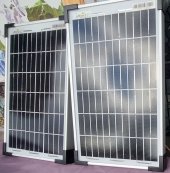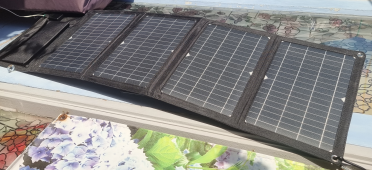Archerite
New Member
I have only been playing with solar for about 3-4 weeks now, but from my understanding a mono crystalline panel always has that square with cut corners look. It reminds me of how the paper and books in battlestar galactica looks like. :D Now I have noticed that my relatively cheap 10 watt panels are actually poly crystalline and that explains some of the "issues" I had with them. Most notably not being able to reach their specified wattage.
Now I got two mono crystaline panels which are also 10 watts each...but I am getting far above their specs at some times! I have them in series and get 24W out of them in the full sun, so I am really happy these are performing great. The thing is it said mono on the amazon page, on the box and even on the label! But they do not have that distinct look that was in the picture or any other mono panel I have seen pictures of.
This is what my so called "mono crystaline" panels look like:

The looks are not what I was expecting but in full sun I do get above specs so I am happy with them. Only wished I had space for a huge 100 watt panel, hahaha. I also have a small foldable panel of 28 watts that does have the distinct mono crystalline look:

I know those are smaller panels in parallel of course, but the most I have got from that panel was about 22 watts. Usually it's much less though around 10-14 watts. Maybe that's because they have a transparent plastic cover over them or it's because the "junction box" also has USB ports besides the DC plug?
Then I also have a huge foldable 120 watts panel that I have not yet been able to utilize to it's max specs. Mostly because when it arrived last week the sun was only available for less than 15 minutes, and other days it was either cloudy or raining so I did not set it up at all. The thing is this panel was also mentioned to be mono crystaline but does not have that specific pattern of the cells:

The most I have got out of this one is around 40 watts when I changed the charge current above the recommended values for my battery for a few seconds. It seems my Victron MPPT does not pull more from the panels than the specified charge current even if the load uses more than that. I tested it while charging my phone that pulls 1.5A at 12v and it was shown as coming out of the battery and not the PV!
The battery used for these experiments is only 7.2Ah which limits the charge current at 2A max. I do have a large 60Ah battery now but not the right cables yet to connect everything safely. Made a mistake when ordering them and an M8 hole won't fit an M10 bolt on the smart shunt and battery disconnect switch!
Sorry about the long story here, my main question is simply: Does a mono-crystaline panel have to look like that specific shape?
Thanks
Now I got two mono crystaline panels which are also 10 watts each...but I am getting far above their specs at some times! I have them in series and get 24W out of them in the full sun, so I am really happy these are performing great. The thing is it said mono on the amazon page, on the box and even on the label! But they do not have that distinct look that was in the picture or any other mono panel I have seen pictures of.
This is what my so called "mono crystaline" panels look like:

The looks are not what I was expecting but in full sun I do get above specs so I am happy with them. Only wished I had space for a huge 100 watt panel, hahaha. I also have a small foldable panel of 28 watts that does have the distinct mono crystalline look:

I know those are smaller panels in parallel of course, but the most I have got from that panel was about 22 watts. Usually it's much less though around 10-14 watts. Maybe that's because they have a transparent plastic cover over them or it's because the "junction box" also has USB ports besides the DC plug?
Then I also have a huge foldable 120 watts panel that I have not yet been able to utilize to it's max specs. Mostly because when it arrived last week the sun was only available for less than 15 minutes, and other days it was either cloudy or raining so I did not set it up at all. The thing is this panel was also mentioned to be mono crystaline but does not have that specific pattern of the cells:

The most I have got out of this one is around 40 watts when I changed the charge current above the recommended values for my battery for a few seconds. It seems my Victron MPPT does not pull more from the panels than the specified charge current even if the load uses more than that. I tested it while charging my phone that pulls 1.5A at 12v and it was shown as coming out of the battery and not the PV!
The battery used for these experiments is only 7.2Ah which limits the charge current at 2A max. I do have a large 60Ah battery now but not the right cables yet to connect everything safely. Made a mistake when ordering them and an M8 hole won't fit an M10 bolt on the smart shunt and battery disconnect switch!
Sorry about the long story here, my main question is simply: Does a mono-crystaline panel have to look like that specific shape?
Thanks




